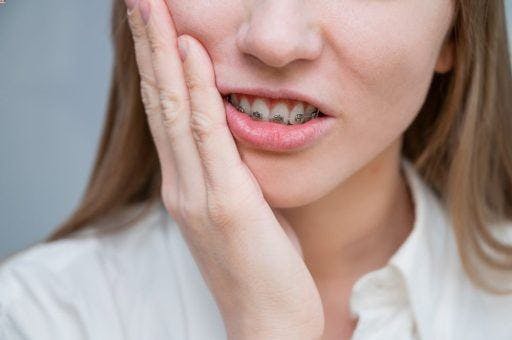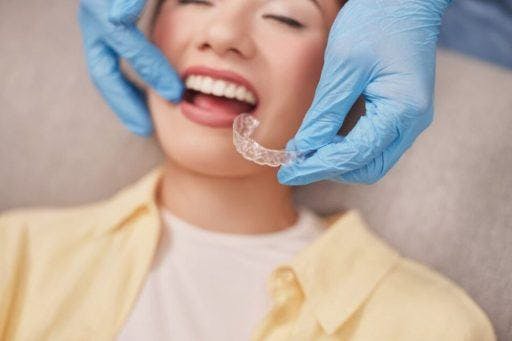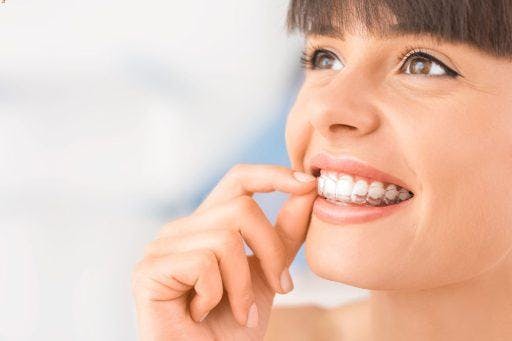The first step to teeth straightening is booking a consultation with your dentist – they’ll always be your best and most reliable resource. The next is doing additional research.
Need more info on teeth straightening in Australia to help you make an informed decision? Read on for the lowdown.
Possible causes of crooked teeth
Why do some people have crooked teeth? Here are the common culprits:
- Genetics. People with small jaws usually have overcrowded teeth. Overbites, underbites, and crowding are conditions you can inherit from past generations.
- Injury or trauma. Damage to the teeth or jawbone may cause teeth to move, becoming crooked or misaligned.
- Impacted teeth. If your wisdom tooth doesn’t grow straight, it can cause the rest of your pearly whites to shift and crowd together.
- Childhood habits. Studies show that prolonged thumb-sucking, tongue-thrusting, or pacifier use can exert pressure on the jaw and teeth, causing misalignment.
- Medical issues. Disorders like rickets, hypothyroidism, or conditions like a cleft palate could hamper jaw and teeth development that could influence alignment.
5 reasons to straighten your teeth

Straight teeth may not have a direct impact on your well-being. In fact, they may not even bother you at all. However, you may need to consider fixing your crooked teeth for several reasons – especially if your misalignment is severe.
1. You have bite problems.
According to a 2023 paper, misaligned teeth or jaws can cause problems when you eat, drink, or speak. They can affect your bite and may even cause unnecessary and painful mouth sores.
2. Your oral hygiene is suffering.
Even people diligent about oral hygiene can overlook the nooks and crannies. Unfortunately, you have more of these easy-to-miss crevices when you have crooked or overlapping teeth.
3. Your teeth are breaking down fast.
Your tooth enamel is the hardest substance in the body, but it doesn’t mean it’s not exempt from degradation. Time and use can strip the surface of your teeth, exposing the more sensitive and cavity-prone dentin underneath. Crooked teeth can cause uneven wear and tear, leading to chipping, cracking, and faster deterioration.
4. Complications may occur.
Severe misalignment can lead to more serious dental issues, such as impacted teeth or the need for extensive orthodontic treatment later in life.
5. Your confidence is low.
According to the International Journal of Environmental Research and Public Health, dental aesthetics impact people, especially younger folk, significantly. Misaligned or crooked teeth can have consequences on self-perception, self-esteem, and quality of life.
Benefits of teeth straightening

Now you know straightening your teeth isn’t just a cosmetic issue. It also involves important health, functionality, and confidence benefits.
1. You’ll get a self-esteem boost.
Face it. You live in a world where straight teeth are more attractive and approachable. Feeling proud about your smile can lift your self-esteem and confidence. It can encourage social interactions, open professional opportunities, and enhance your overall quality of life.
2. You can enjoy better oral and dental health.
Straighter teeth make for easier brushing and flossing, reducing chances of missing inaccessible plaque-ridden surfaces or sneaky debris. It means less risk of cavities and gum disease. Moreover, you can also avoid future complications associated with misalignment, such as tooth impaction or bone loss.
3. Your speech may improve.
Severely crooked or misaligned teeth can affect your tongue’s placement, causing a whistle or lisp. However, straightening your teeth can correct malocclusion-caused speech impediments.
4. You’ll have a more efficient bite.
Straightening malocclusions means making your bite more balanced, alleviating pressure on the jaw joints and muscles. It could prevent temporomandibular joint (TMJ) disorders, jaw pain, and headaches.
Plus, even teeth distribute the forces of chewing and biting more uniformly, slowing down dental wear and tear.
Teeth straightening options
Many teeth straightening options are available in the market, depending on the severity of your condition. Consult your orthodontist to see which treatment will work best for you.
1. Traditional braces
Braces come in different varieties. Some brackets comprise stainless steel, ceramic, composite, titanium, or even plastic. Even how braces are held together can vary depending on your orthodontist’s recommendation. Damon braces have a sliding mechanism and no elastic ties while self-ligating braces feature a specialised click to hold the wire in place. On the other hand, lingual braces are placed on the backside instead of the front.
2. Aligners

Aligners are custom-made, removable, clear plastic trays that you affix over your teeth. They are virtually invisible, and you can take them out for eating and cleaning.
ClearCorrect is one such example. It uses a stain-resistant tri-layer ClearQuartz material engineered to realign your teeth gently but successfully. It also has an unscalloped and high trimline designed to be more flexible to reduce the pressure near the gums, making it more comfortable while also efficient.
3. Veneers
Veneers, or laminates, are custom-made shells of tooth-coloured materials designed to cover the front surface of teeth. The process involves shaving about 0.5mm of your enamel. It can solve only minor alignment issues.
4. Retainers
Retainers come after braces. They are typically made of wires and acrylic, although modern variations have been developed. Retainers prevent teeth from resuming their old position after braces or other orthodontic treatments.
Teeth straightening myths
Put on your myth-buster hat. It’s time to set the record straight on a few common misconceptions about orthodontic treatments!
Myth #1: Teeth straightening is only for young adults.

One common misconception is there’s an “acceptable” and limited time for someone to undergo treatment. Young adults wearing clear aligners on social media perpetuate this idea. But you can straighten your teeth whenever you’re ready. As the Australian Society of Orthodontists (ASO) explains, there is no cut-off age for teeth straightening.
Given how discreet and nondisruptive aligners are to your daily life, they’re a viable solution for all ages. Successful teeth alignment doesn’t depend on how young or old you are. Instead, it hinges on working with an orthodontic professional who can maximise the aligners’ corrective abilities.
Myth #2: Improving teeth alignment changes your face shape.
A combination of soft and hard tissues determines your face shape. As you age, the soft tissues in your face naturally lose firmness, leading to sagging. Meanwhile, hard tissues refer to the bones, which require extensive procedures like bone-cutting surgery to transform. So, don’t let anyone tell you addressing teeth misalignment can shrink your face and drastically change its shape.
At most, orthodontic treatment can change your facial profile, but not by much. As the ASO notes, “Changes to your facial shape from orthodontic treatment can be minor, depending on the severity of the problems being treated.” Aligners might straighten your profile by a few millimetres, but major movements may still require orthognathic (jaw) surgery. They’re beyond the scope of what orthodontic appliances can accomplish.
Myth #3: All orthodontic treatments are equally painful.
Do you subscribe to the phrase, “no pain, no gain”? It’s reasonable to assume that getting what you want (in this case, straight teeth) requires suffering. That may be why people think all orthodontic treatments are painful. But clear aligners offer a different experience than traditional, metal-wired braces thanks to their design.
In one study published in the International Dental Journal, researchers found that “patients treated with aligners reported less pain and greater quality of life throughout orthodontic treatment,” compared to patients treated with fixed appliances.
The soft plastic material of clear aligners gives them some elasticity, making them more comfortable for the wearer. They apply an appropriate amount of force on teeth – not too much or too little. Remember – excessive force can damage the teeth and their surrounding nerves. Keeping the pressure constant but gentle is the key to painless orthodontics.
Still, you can expect a bit of pressure sensitivity when wearing clear aligners. That comes with trying to move the teeth into their new positions. Bone remodelling around the roots can lead to mild discomfort, but it usually goes away after your teeth get used to a new set of aligners.
Myth #4: Aligners only work for small movements.

Since clear aligners are comfortable and easy to wear, people assume they only work for “simple” teeth correction cases or small movements. For example, patients with minor diastema (a gap between the upper front teeth) might be more inclined to seek treatment than those with advanced crowding. But the reality is aligner therapy has come a long way since its early days.
One case report published in the Journal of Aligner Orthodontics detailed the diagnosis and treatment for a patient with “Class III skeletal and dental malocclusion.” The report noted that cases like these can be “some of the most difficult [to treat], especially in non-growing patients.”
But after 46 months, the aligner treatment successfully helped correct the patient’s complex malocclusion without requiring surgery. The report concluded that “clear aligners can be a viable treatment option for appropriately selected Class III malocclusion cases.”
That’s just one example of clear aligners being on par with traditional orthodontic appliances. While there are still some situations where orthodontists might recommend additional tools to assist movement, aligners are more than capable of tackling most cases. Unsure if your misaligned teeth are treatable with ClearCorrect? Take this online smile assessment to know if you’re a candidate.
Myth #5: Aligner treatment takes longer than braces.
Many believe something as desirable as straight teeth should take forever to achieve. Some even expect the process to be an inconvenience to be effective. Since removable aligners hardly disrupt your day-to-day, it’s easy to think they need more time to address misalignment vs. braces. But the opposite is true – at least, for specific cases.
Aligners cover more surface area and apply customised pressure per tooth, significantly shortening treatment time. Of course, duration also depends on a patient’s condition and their goals. Smaller movements can take as little as three months, while more complex ones can take up to four years.
The ASO also notes, “Every small amount of time (around two hours a day at a minimum) [aligners] are out of your mouth, your treatment is delayed.” Since clear aligners are removable, the patient needs to be responsible about wear time; otherwise, they risk extending their treatment.
Make better, more informed decisions about teeth straightening by arming yourself with accurate information. After all, these myths are just the tip of the iceberg! There’s more to learn and debunk, so read up – discover the science behind clear aligners, then find out how your smile impacts your face. And don’t forget to seek professional advice, too – your dentist will know how best to help you.
References:
Baum, A. (2023). Am I too old for orthodontic treatment? American Association of Orthodontists.
Robertson, L. R., Lee, D. L., Elmar, H. E., & El-Bialy, T. E. (2019). Treatment of a Challenging Class III malocclusion case using Invisalign clear aligners and micro-osteoperforation: a case report. Journal of Aligner Orthodontics, 3(3).
Rouzi, M., Zhang, X., Jiang, Q., Long, H., Lai, W., & Li, X. (2023). Impact of clear aligners on oral health and oral microbiome during orthodontic treatment. International Dental Journal.



